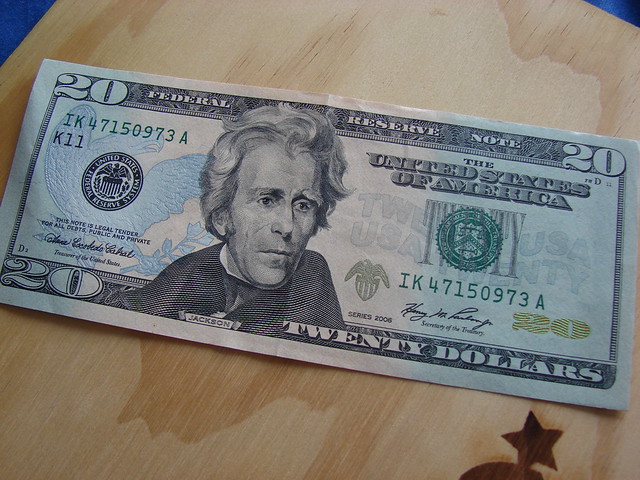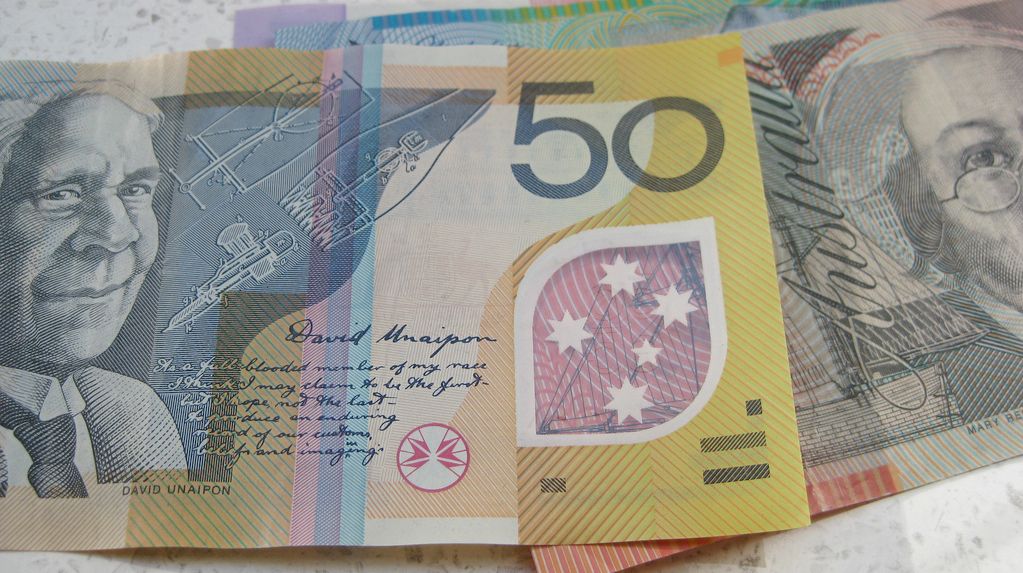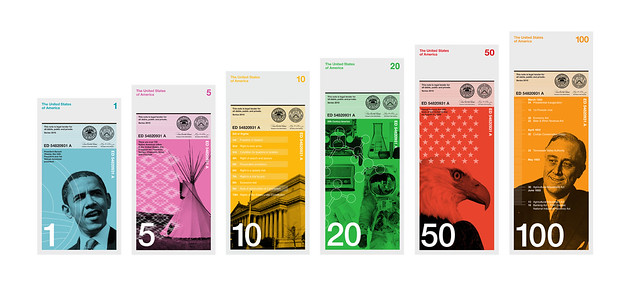Playlist: O'Dark 30 episode 145 (3-41)
Compiled By: KUT

KUT's O’Dark 30 bounces back from the Labor Day weekend with more of the very best from the world of independent radio production. Every Sunday at midnight on Austin's KUT 90.5 and also at 4pm on digital KUT2 we present 3 hours of a little bit of everything from the world of independent radio production.
Episode 145 (3-41) includes 99% Invisible #54- The Colour of Money...The Mikie Show #41, Sarah...99% Invisible #55- The Best Beer in the World...Oh, Where Have You Been, My Blue-Eyed Son...Man With a Blue Truck...Rodriguez: Searching for Sugar Man...A Wild Life...Groundhog and Mirror...An Occurrence at Owl Creek Bridge
99% Invisible #54- The Colour of Money (Standard 4:30 version)
From Roman Mars | Part of the 99% Invisible (Standard Length) series | 04:29
Australia made its money better. Why can't the US?
US paper currency is so ubiquitous that to really look at its graphic design with fresh eyes requires some deliberate and focused attention. So pull out a greenback from your wallet (or look at a picture online) and really take it in. All the fonts, the busy filigree, the micro patterns…it’s just dreadful. Even though paper currency itself, just idea of money, is a massive, world changing technology, the look and feel of US paper money is very stagnant. Richard Smith is the founder of the Dollar ReDe$ign Project and in an article in the New York Times, he pointed out five major areas where the design of US currency could improve: color, size, functionality, composition, and symbolism. The worst aspects of the design of the greenback are illustrated in this video by Blind Film Critic Tommy Edison. It just so happens that Australian currency addresses each and every one of the points made by Richard Smith. Tristan Cooke and Tom Nelson of the blog Humans in Design are big fans of all the design innovations in Australian money. Aussie polymer notes are varied in color, get larger with each denomination, are more durable and are generally considered better and easier to use than US currency. But there are some interesting reasons why the greenback is the way it is. David Wolman, author of The End of Money, explains that the legacy features that make US paper money look stale and anachronistic are meant to convey stability and timelessness. Since the US economy is so important in the world economy, why mess with it? Some fear that changing the design of the currency significantly (or eliminating the penny) could undermine the faith in the federal reserve note. Even though Tristan and Tom are fans of the Australian polymer bills, they share Wolman’s view that the more interesting future innovations are not going to have anything to do with physical cash. Clever user interfaces that help us manage our money better, while providing even greater convenience, are getting more refined and accepted. So that ugly $20 in your wallet may never actually get prettier and more functional, it’ll just be gone. Extra: Below is the 2010 winner of Richard Smith’s Dollar ReDe$ign Project, submitted by Dowling Duncan. [For Director's Cut, go to: http://www.prx.org/pieces/89176-99-invisible-54-the-colour-of-money-director-s]
[For Director's Cut, go to: http://www.prx.org/pieces/89176-99-invisible-54-the-colour-of-money-director-s]
The Mikie Show #41, Sarah
From Michael Carroll | Part of the The Mikie Show series | 28:03
This episode we speak with Sarah Luchetta, an archaeologist, French speaker and roller derby girl. What was that, roller derby girl? Yes, besides investigating the artifacts of human history, she likes participating in a contact sport. Roller Derby is back in a revised edition that’s truly a sport this time. New clubs are popping up all over these days and we find out why. There’s another guest coming by as well but I haven’t heard that part yet so I don’t know who that will be. And we have a quiz, and some news from around the area. All in all, it’s twenty-eight minutes of a smashing good time!
- Playing
- The Mikie Show #41, Sarah
- From
- Michael Carroll

This episode we speak with Sarah Luchetta, an archaeologist, French speaker and roller derby girl. What was that, roller derby girl? Yes, besides investigating the artifacts of human history, she likes participating in a contact sport. Roller Derby is back in a revised edition that’s truly a sport this time. New clubs are popping up all over these days and we find out why. There’s another guest coming by as well but I haven’t heard that part yet so I don’t know who that will be. And we have a quiz, and some news from around the area. All in all, it’s twenty-eight minutes of a smashing good time!
99% Invisible #55- The Best Beer in the World (Standard 4:30 version)
From Roman Mars | Part of the 99% Invisible (Standard Length) series | 04:30
They made it perfect--but not for you.
Oh, Where Have You Been, My Blue-Eyed Son?
From Third Coast International Audio Festival | Part of the 2012 ShortDocs: Neighbor Stories series | 02:59
Liza introduces her new love, Jonah.
 Liza introduces her new love, Jonah.
Liza introduces her new love, Jonah.
"Oh, Where Have You Been, My Blue-Eyed Son?" was produced by Belinda Lopez for the 2012 Third Coast ShortDocs Challenge, a collaboration with EveryBlock, which invited anyone and everyone to produce short audio works featuring at least two neighbors, a color in the title, and three consecutive seconds of narrative silence.
Man With A Blue Truck
From Third Coast International Audio Festival | Part of the 2012 ShortDocs: Neighbor Stories series | 03:00
Who knew a hit and run could end in friendship?
 Who knew a hit and run could end in friendship?
Who knew a hit and run could end in friendship?
"Man With a Blue Truck" was produced by Eve Abrams for the 2012 Third Coast ShortDocs Challenge, a collaboration with EveryBlock, which invited anyone and everyone to produce short audio works featuring at least two neighbors, a color in the title, and three consecutive seconds of narrative silence.
Rodriguez: Searching For Sugar Man
From Joyride Media | 59:00
Rodriguez was a music legend in South Africa, but it took 25 years for him to find out.
- Playing
- Rodriguez: Searching For Sugar Man
- From
- Joyride Media

A Wild Life
From Erica Kramer | 06:22
Gus Ben David's home is a zoo. His Wildlife Farm is comprised of hundreds of creatures and Gus' days are devoted to their care.
- Playing
- A Wild Life
- From
- Erica Kramer
 Gus Ben David's home is a zoo. His Wildlife Farm is comprised of hundreds of creatures and Gus' days are devoted to their care.
Gus Ben David's home is a zoo. His Wildlife Farm is comprised of hundreds of creatures and Gus' days are devoted to their care.
Groundhog and Mirror
From Ronan Kelly | 11:28
Jane O'Connor is a young woman from Dublin whose mother was a big fan of the film Groundhog day. The irony of her beloved film choice was that when diagnosed with Alzheimers, everyday became Groundhog day. This is an intimate tale of love and sorrow, of a daughters final years with her mother
- Playing
- Groundhog and Mirror
- From
- Ronan Kelly
 Jane O'Connor is a young woman from Dublin whose mother was a big fan of the film Groundhog day. The irony of her beloved film choice was that when diagnosed with Alzheimers, everyday became Groundhog day. This is an intimate tale of love and sorrow, of a daughters final years with her mother
Jane O'Connor is a young woman from Dublin whose mother was a big fan of the film Groundhog day. The irony of her beloved film choice was that when diagnosed with Alzheimers, everyday became Groundhog day. This is an intimate tale of love and sorrow, of a daughters final years with her mother
An Occurance At Owl Creek Bridge by Ambrose Bierce
From Roy Trumbull | 25:32
During the Civil War a southern civilian is to be executed by being hung from a bridge. What happens or doesn't happen next we won't know until the end of the story. This Ambrose Bierce tale is considered by many to be one of the best American short stories of the 19th century.
 During the Civil War a southern civilian is to be executed by being hung from a bridge. What happens or doesn't happen next we won't know until the end of the story. This Ambrose Bierce tale is considered by many to be one of the best American short stories of the 19th century.
During the Civil War a southern civilian is to be executed by being hung from a bridge. What happens or doesn't happen next we won't know until the end of the story. This Ambrose Bierce tale is considered by many to be one of the best American short stories of the 19th century.


